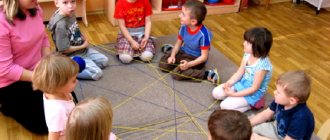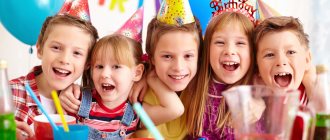Speech is one of the most important means of developing a child’s personality as a whole. Understanding the speech of others and one’s own active speech accompany all the child’s activities. The speech development of a child in the first years of life has an impact on his entire subsequent life, therefore speech development must begin from the first days of the child’s life. Timely and complete mastery of speech is the first most important condition for the formation (appearance) of a full-fledged psyche in a child and its further correct development. Timely means started from the very first days after the birth of the child; “full-fledged” means sufficient in terms of the volume of language material and encouraging the child to master speech to the full extent of his capabilities at each age level.
Every child must learn to express their thoughts meaningfully, grammatically correct, coherently and consistently. At the same time, children’s speech should be lively, spontaneous, and expressive.
The problem of speech formation in preschool children is relevant today. Formation of speech in preschoolers is an important and difficult task. The successful solution of this problem is necessary both for preparing children for the upcoming school education, and for comfortable communication with others. However, the development of speech in children in the present tense is a pressing problem, which is due to the importance of coherent speech for preschoolers.
Traditional methods of teaching preschoolers recommend using a teacher's story sample as the main teaching technique. But experience shows that children reproduce the teacher’s story with minor changes, the stories are poor in expressive means, the vocabulary is small, and there are practically no simple common and complex sentences in the texts. But the main disadvantage is that the child does not construct the story himself, but only repeats what he heard. During one lesson, children have to listen to several monotonous stories of the same type. For children, this type of activity becomes boring and uninteresting, they begin to get distracted. It has been proven that the more active a child is, the more he is involved in activities that interest him, the better the result. The teacher needs to encourage children to engage in speech activity, and it is also important to stimulate speech activity not only in the process of free communication, but, above all, in speech therapy classes.
It became obvious that it was necessary to change the way teachers work in classes on the development of speech of preschoolers. Such means are innovative methods and techniques for developing speech in preschoolers.
Currently, it is no longer possible to imagine the development of modern society and production without information and communication technologies. Today, ICTs are beginning to occupy their niche in the educational space of preschool educational institutions. This allows:
- present information on the monitor screen in a playful form, which arouses great interest in children, since this corresponds to the main activity of a preschooler - play; — present new material brightly, figuratively, in a form accessible to preschoolers, which corresponds to the visual-figurative thinking of preschool children; - attract children's attention with movement, sound, animation; - encourage children to solve a problem problem, using the capabilities of the curriculum, which is a stimulus for the development of their cognitive activity; — develop exploratory behavior in preschoolers; - expand the creative capabilities of the teacher himself.
Currently, teachers in educational institutions face the most important task: developing children’s communication skills.
The task of teachers is to create conditions for the practical mastery of spoken language for each child, to choose such teaching methods and techniques that would allow each student to demonstrate their speech activity, their word creativity. One of the most common techniques for developing a child’s speech is Mnemonics.
Mnemonics, or mnemonics, is a system of various techniques that facilitate memorization and increase memory capacity by forming additional associations. Such techniques are especially important for preschoolers, since visual material is absorbed better than verbal material.
Features of the technique are the use not of images of objects, but of symbols for indirect memorization. This makes it much easier for children to find and remember words. The symbols are as close as possible to the speech material, for example, a Christmas tree is used to designate wild animals, and a house is used to designate domestic animals.
Like any work, mnemonics is built from simple to complex. It is necessary to start working with the simplest mnemonic squares, sequentially move on to mnemonic tracks, and later to mnemonic tables, because children retain individual images in their memory: a Christmas tree is green, a berry is red. Later - complicate it or replace it with another screensaver - depict the character in graphic form.
Mnemonic tables - diagrams serve as didactic material in the development of coherent speech in children. They are used: to enrich vocabulary, when learning to compose stories, when retelling fiction, when guessing and making riddles, when memorizing poetry.
In older groups, any lesson begins with research activity, therefore the use of such pedagogical technology as research activity is one of the components of any lesson. Technology such as sign-symbolic activity (modeling) has become widely used in teaching children. This technique helps teachers visually identify elementary connections and relationships between objects and objects of reality.
It is recommended for children of younger and middle age to draw colored mnemonic tables, since the children retain separate images in their memory: the fox is red, the mouse is gray, the Christmas tree is green, and for older preschoolers - black and white. Older preschoolers can participate in drawing and coloring themselves.
Mnemonic table for memorizing the poem by E. Mikhailova “What is the New Year?”
Models are especially effective when learning poems. The bottom line is this: a key word or phrase in each line of poetry is “encoded” with a picture that has a suitable meaning, thus the entire poem is sketched automatically. After this, the child reproduces the entire poem from memory, relying on a graphic image. At the initial stage, I offer a ready-made plan diagram, and as the child learns, he is actively involved in the process of creating his own diagram.
In the process of speech development of children of senior and preparatory groups, special subject-based schematic models are used. When forming children's ideas about words and sentences, children are introduced to the graphic diagram of a sentence. The teacher says that without knowing the letters, you can write a sentence. Individual lines in a sentence are words. Children can be asked to construct a sentence (Cold winter has come. A cold wind is blowing).
Graphic diagrams help children more specifically sense the boundaries of words and their separate spellings. In this work you can use various pictures and objects.
For verbal analysis of sentences in preparatory groups, educators use the “living words” model. There are as many words in a sentence as the teacher calls the children. Children stand in order according to the sequence of words in the sentence.
To develop the speech of preschool children, teachers use a technique called fairytale therapy. Fairytale therapy is recommended to be carried out once a week. In the younger and middle groups, the duration of fairy tale therapy is 15–20 minutes. In the senior and preparatory groups 25 - 30 minutes. When conducting fairy tale therapy in junior and middle groups, the main methods used are verbal - director's play, psycho-gymnastics, verbal commentary, joint verbal improvisation - learning to continue the teacher's suggestions, complementing the description of the emotional state of the characters (children wake up Burenka). In older groups, they use the same methods, but complicate the tasks; children perform interesting tasks such as pantomime etudes, rhythmic exercises, etc.
The use of multimedia aids in the development of speech in preschool children significantly optimizes the educational process, expanding the possibilities of presenting material. Proper use of methods of presenting information allows you to simultaneously use all the student’s senses, activating his cognitive abilities.
The method we use to organize educational activities on the development of speech in preschoolers contributes to the formation of stable knowledge in students.
The use of articulatory gymnastics plays an important role in the development of children's speech. Articulatory gymnastics is a set of special exercises aimed at strengthening the muscles of the articulatory apparatus, developing strength, mobility and differentiation of movements of organs involved in the speech process. Articulatory gymnastics is the basis for the formation of speech sounds - phonemes - and the correction of sound pronunciation disorders of any origin; it includes exercises for training the mobility of the organs of the articulatory apparatus, practicing certain positions of the lips, tongue, soft palate, necessary for the correct pronunciation of both all sounds and each sound of a particular group.
The goal of articulatory gymnastics is to develop full-fledged movements and certain positions of the organs of the articulatory apparatus necessary for the correct pronunciation of sounds.
The success of children's education at school largely depends on their level of mastery of coherent speech. Perception and reproduction of textual educational materials, the ability to give detailed answers to questions, independently express one’s opinions - all these and other educational activities require a sufficient level of development of coherent speech.
The development of children's speech and vocabulary, mastery of the riches of their native language is one of the main elements of personality formation, the development of developed values, national culture, is closely related to mental, moral, aesthetic development, and is a priority in language education and training of younger schoolchildren. We assume that the active introduction of various methods of work on speech development into the educational process will contribute to the formation of communication skills, the development of independent creative thinking, the emotional world of the child, and the formation of a positive attitude towards learning.
Speech is a human activity, the use of language for communication, to convey one’s thoughts, intentions, and feelings. Speech is varied. This is a conversation between friends, a monologue by an artist, a call from a speaker, a student’s response in class, and a scientific work. Work on speech development requires a variety of techniques and means. During classes, the learning situation and motives of speech change many times. Students either speak freely or perform a task that disciplines thought and directs their speech activity in a strict direction. When working on speech development, it is necessary to combine both. Well-developed speech is one of the most important means of human activity in modern society, and for a schoolchild it is a means of successful learning at school. Speech is a way of understanding reality. On the one hand, the richness of speech largely depends on the child’s enrichment with new ideas and concepts; on the other hand, good command of language and speech contributes to the successful knowledge of complex connections in nature and in the life of society.
References 1. Polat E.S. New pedagogical technologies. - M., 2000. 2.Robert I.V. Modern information technologies in education. - M., Shkola-Press, 1994. 3. Elkonin D.B. Psychology of the game. - M., Vlados, 1999. 4. Yakovlev A.I. Information and communication technologies in education. 2005
5. Bolshova T.V. We learn from a fairy tale. Development of thinking in preschoolers using mnemonics. St. Petersburg, 2005.




